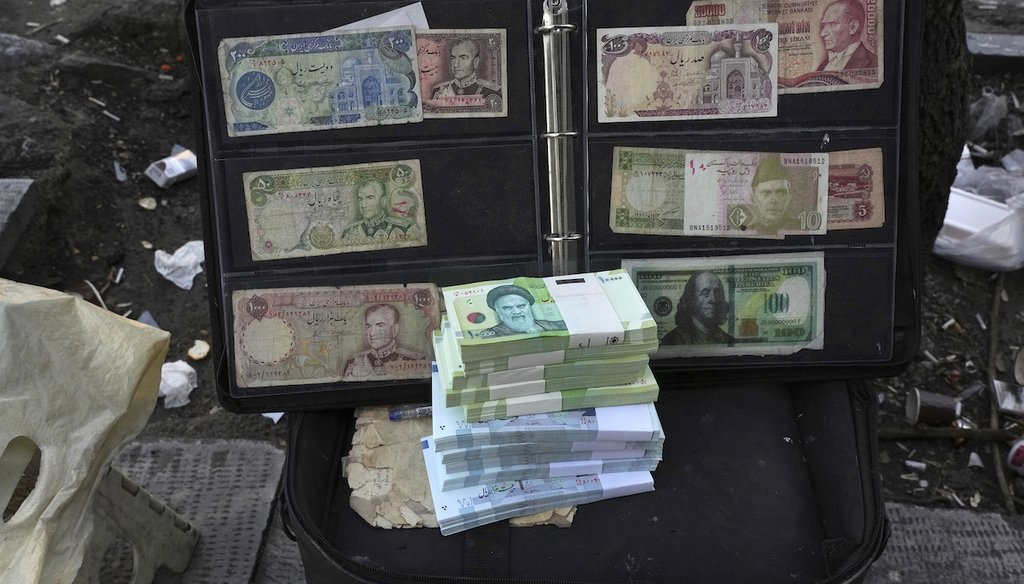

Our only agenda is to publish the truth so you can be an informed participant in democracy.
We need your help.


Current and pre-revolution Iranian banknotes and foreign currencies are displayed by a vendor in downtown Tehran, Iran, on Feb. 26, 2023. (AP)
Trump’s numbers are off — Iran’s reserves were larger than he states and did not drop to zero — but he’s on point about the plummeting trend line.
Iran’s foreign currency reserves fell from $128 billion in 2015 to $15 billion in 2019, which represents an even more dramatic decline in absolute dollars than Trump said.
This decline is widely believed to be a consequence of the tightened U.S. sanctions under Trump and it has not reversed to any significant degree since.
During a rally in New Hampshire, former President Donald Trump touted his administration’s policies on Iran, saying they weakened the country’s government.
At the Oct. 23 rally in Derry, New Hampshire, Trump cited efforts during his presidency to starve Iran’s hard-line religious government of foreign currency, in hopes of hampering the country’s support for militant groups.
"When I came into office, Iran had $70 billion in foreign exchange reserves," Trump said. "It was loaded up with money that's from Obama. His piggy bank was full and it was also full of terrorists. By the time I left, they had nothing. They were broke. They were broke."
Trump’s numbers are off. But his description of the plummeting trend line holds up — the plunge was about 60% more dramatic than the figures he used.
The Trump campaign did not respond to an inquiry for this article.
In 2018, the Trump administration pulled out of the 2015 nuclear agreement with Iran, which was premised on Iran curtailing its nuclear efforts in exchange for a loosening of economic sanctions. The U.S. exit from the deal meant that those sanctions snapped back into place.
"Scores of international companies announced that they would end or suspend their operations in Iran even before U.S. sanctions were formally re-imposed," according to the International Crisis Group, an organization that advocates for conflict avoidance. The sanctions, some of them old and some newly crafted, began to be enforced in 2018.
When foreign entities purchase Iranian goods, they typically pay either in U.S. dollars, their own currency, or another widely used currency such as euros. So, making it harder for Iran to conduct business with other countries meant that its supply of foreign currency dwindled, as existing Iranian stashes of foreign currency weren’t replaced when spent on overseas goods.
This can have a serious impact on a nation’s economy. It can make it harder to import needed goods, which could dampen economic output and increase inflation and unemployment. The country’s own currency usually loses value against other currencies, as well.
Official data shows that foreign currency reserves in Iran’s central bank climbed steadily from about $2 billion to about $128 billion from 2000 to 2015, including a period of intense negotiation between the U.S., Iran and other countries over the nuclear deal. The level of foreign reserves remained high through the early part of Trump’s tenure, but after the sanctions hit, Iran’s foreign holdings fell precipitously, declining to about $15 billion in 2019.
That’s not "zero." Iran had more than $70 billion in reserves when Trump took office, but the fall was dramatic. In absolute dollars, Trump’s figures understated the scale of the decline; he said it was $70 billion, but it was actually about 60% bigger: $113 billion.
"The policy that the Trump administration pursued led to a significant decline in the readily available official reserves of Iran," or the foreign currency to which Tehran has full access, said Saeed Ghasseminejad, a senior adviser on Iran with the Foundation for the Defense of Democracies, a right-leaning think tank in Washington, D.C.
The sanctions policies the Trump administration pursued were "a key reason for Iran’s decreased exports and imports, massive inflation, and significant depreciation of the rial," its currency, Ghasseminejad said.
Iran’s foreign currency reserves have since risen to about $24 billion, but that remains well below their pre-Trump level.
The Trump-era sanctions did not lead to the ouster of Iran’s government, and it continues to play an international role at odds with U.S. foreign policy. But on the metric of foreign reserves, Trump was close to accurate.
Trump said, "When I came into office, Iran had $70 billion in foreign exchange reserves. … By the time I left, (it was) nothing. They were broke."
His numbers are off. Iran’s reserves were larger than he said and they did not fall to zero. But he’s on point about the trend line: Iran’s foreign currency reserves fell from $128 billion in 2015 to $15 billion in 2019, a plunge nearly 60% bigger in absolute dollars than Trump said.
This decline is widely believed to be a consequence of the tightened U.S. sanctions under Trump, and it has not reversed to any significant degree since.
The statement is partially accurate. We rate it Half True.
Donald Trump, rally in Derry, N.H., Oct. 23, 2023
Federal Reserve Bank of St. Louis, "Gross International Reserves Held by Central Bank for Iran, Islamic Republic of," accessed Oct. 25, 2023
International Crisis Group, "Iran Sanctions under the Trump Administration," Jan. 15, 2020
PolitiFact, "Trump’s pledge to renegotiate Iran deal remains at standstill as election nears," July 15, 2020
Email interview with Saeed Ghasseminejad, senior adviser on Iran with the Foundation for the Defense of Democracies, Oct. 24, 2023
In a world of wild talk and fake news, help us stand up for the facts.
